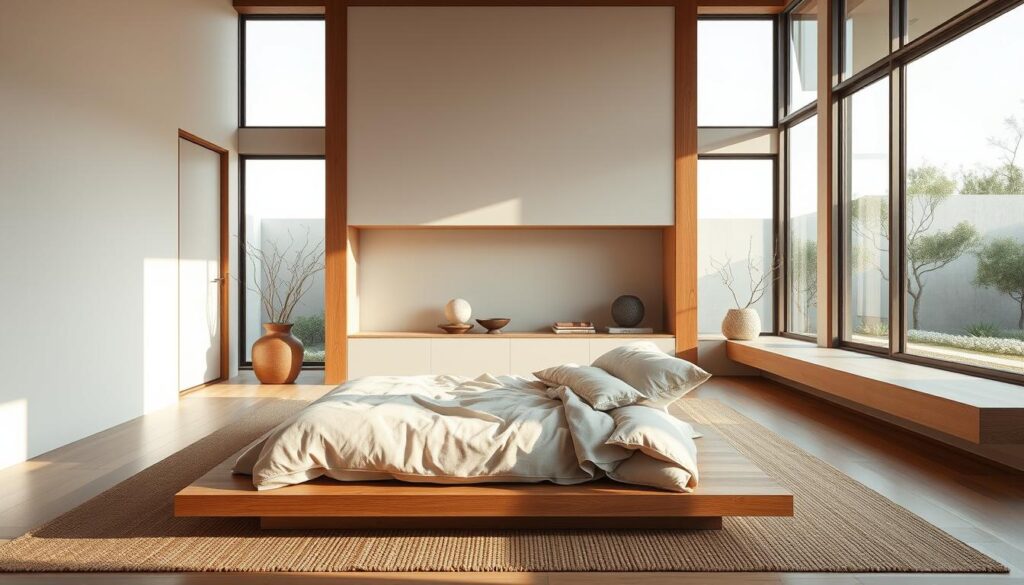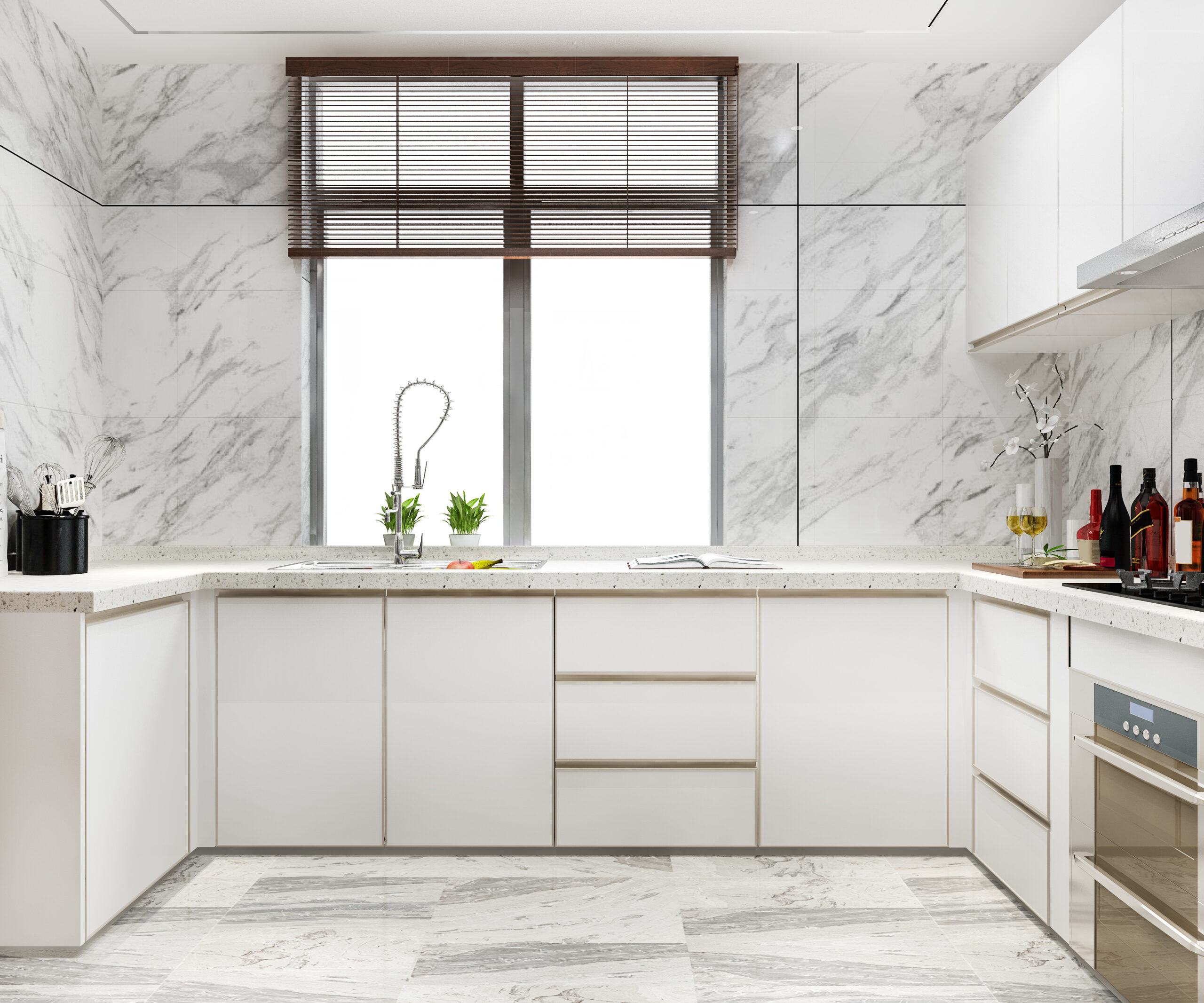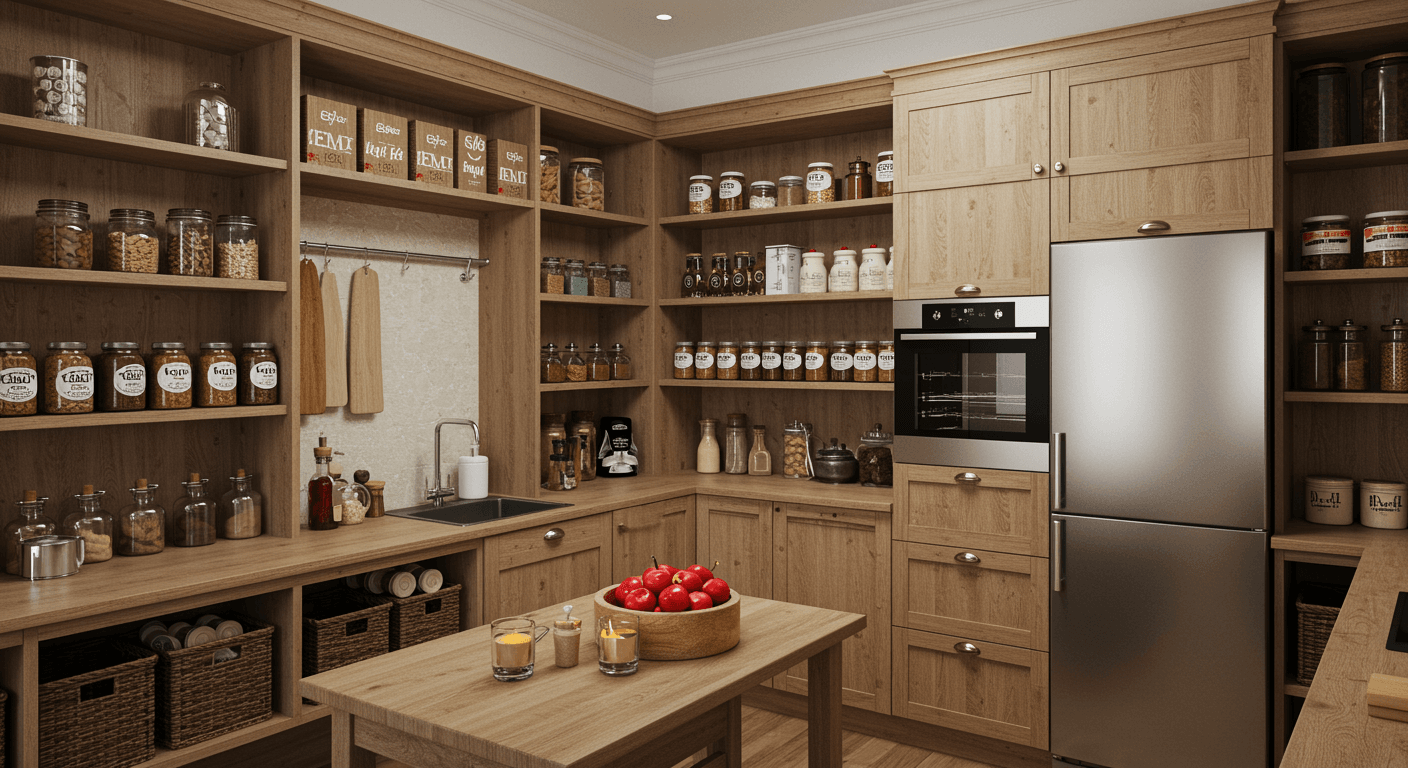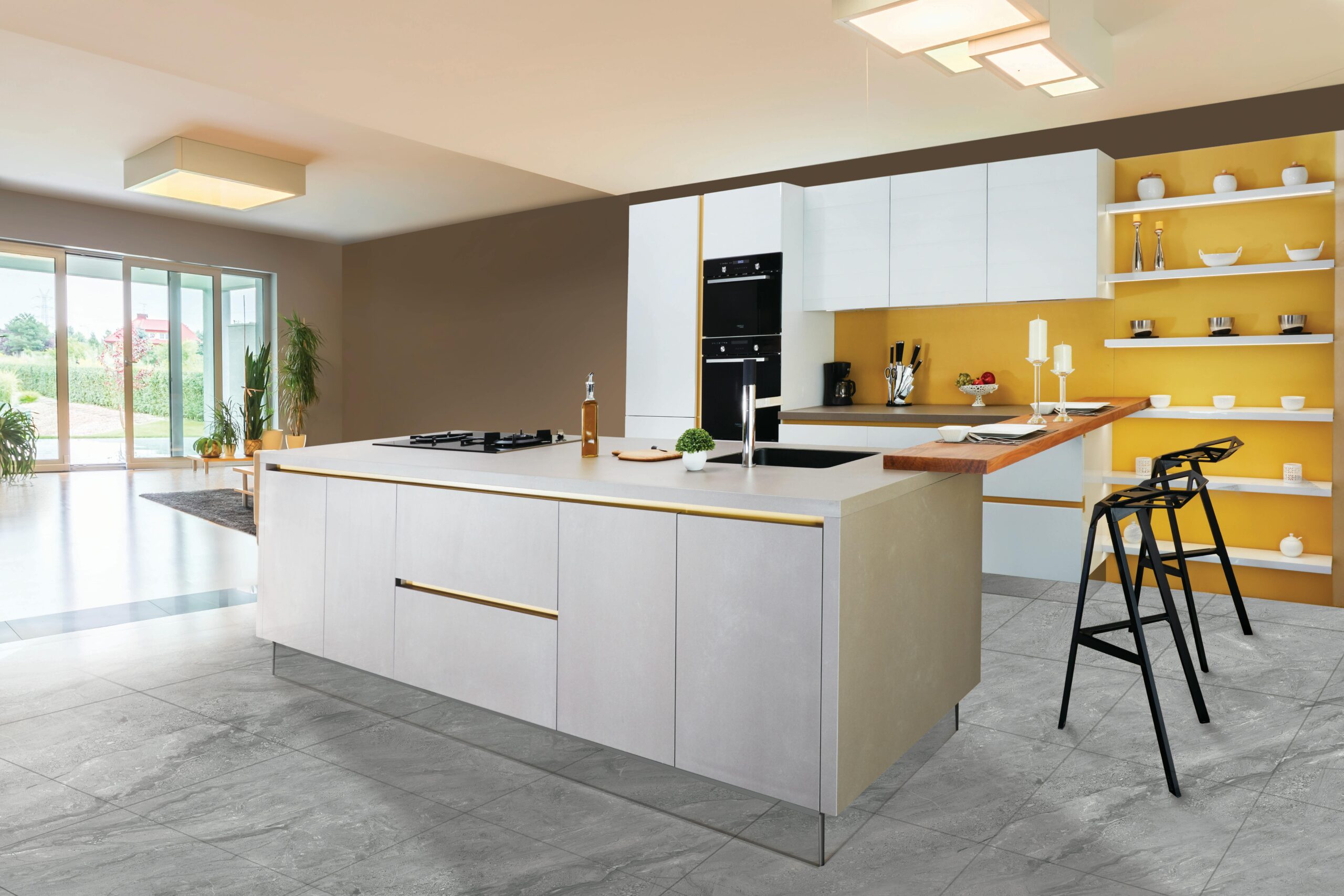We are witnessing a growing trend toward minimalist design approaches that create peaceful, balanced living environments. At the forefront of this movement is Japandi style, a fusion of Scandinavian and Japanese aesthetics that emphasizes simplicity and natural elements.
This unique style combines the best of both worlds, promoting harmony and comfort through clean lines, neutral color palettes, and thoughtfully curated spaces. As homeowners and designers seek calm, clutter-free environments, Japandi design stands out as a compelling choice, addressing fundamental human needs for tranquility and connection to nature.
Key Takeaways
- Japandi style brings together Scandinavian and Japanese design elements for a serene living space.
- The fusion promotes harmony and comfort through clean lines and natural materials.
- Japandi design is ideal for those seeking a calm, clutter-free environment.
- It addresses fundamental human needs for simplicity and tranquility.
- The style is characterized by neutral color palettes and thoughtfully curated spaces.
Understanding the Essence of Japandi Design
At its core, Japandi design is a harmonious blend of Japanese and Scandinavian aesthetics. This design movement brings together the minimalist principles of Japanese design and the functionality of Scandinavian design, creating spaces that are both serene and highly practical.
What Is Japandi Style?
Japandi style is essentially a thoughtful marriage between Japanese minimalism and Scandinavian functionality. Wijaya explains that “it is the East-meets-West design movement that blends Japanese artistic elements and wabi-sabi philosophy with Scandinavian comfort and warmth or hygge.” The result is a design aesthetic that is focused on simplicity, natural elements, comfort, and sustainability.
- Minimalist Approach: Japandi interiors typically feature a restrained color palette, natural textures, and clean lines, emphasizing quality over quantity.
- Natural Elements: There's a strong emphasis on incorporating natural elements and greenery, bringing a sense of calm and connection to nature indoors.
The Perfect Fusion of East and West
The essence of Japandi design lies in its ability to balance seemingly opposite qualities: warmth and coolness, light and dark, soft and structured. Japanese design contributes the principles of wabi-sabi, an appreciation for craftsmanship, and a deep connection to nature. Scandinavian design brings brightness, functionality, and the concept of hygge, resulting in spaces that feel both serene and welcoming.
“Both Japanese and Scandinavian design aesthetics are focused on simplicity, natural elements, comfort, and sustainability,” Wijaya explains.
By merging these two design philosophies, Japandi style creates a harmonious whole that feels both curated and effortless, making it perfect for modern living spaces.
Get Cabinet Quote ( In 24 Hours )
The Rich History Behind Japandi Design
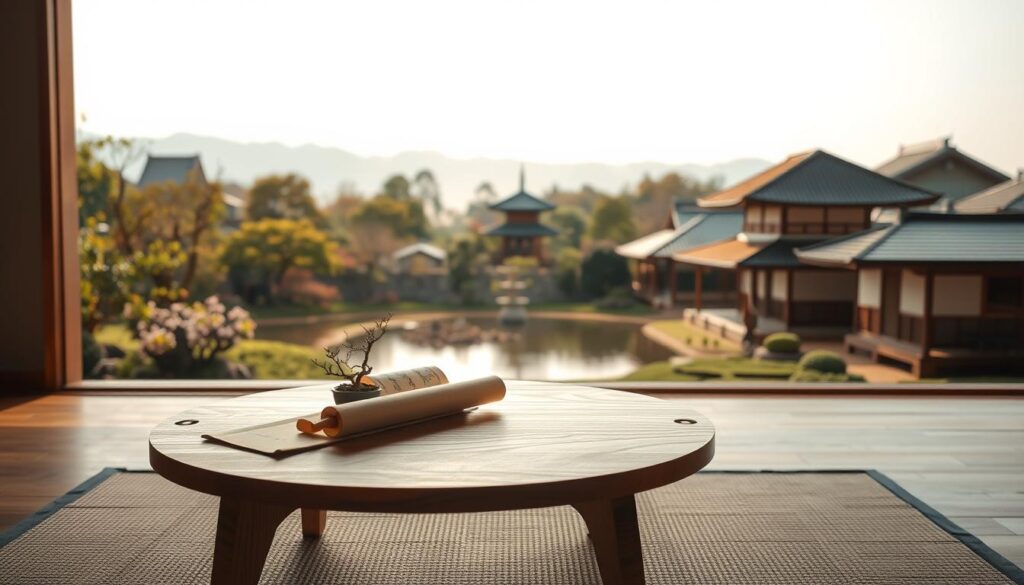
The story of Japandi interior design begins in the mid-19th century when Japan opened its borders to the world. “After the closed-border policy of Japan, which lasted for around 200 years, they opened their borders in the mid-1850s,” Rietbergen explains. This marked the beginning of a cultural exchange between Japanese Scandinavian influences and Scandinavia that would eventually give rise to the Japandi aesthetic, blending natural elements and decor styles over the years.
Japanese Design Influences
Japanese design has contributed significantly to the Japandi style, bringing with it centuries-old traditions of minimalism and precision. The wabi-sabi philosophy, which embraces imperfection and transience, is still evident in contemporary Japandi interiors and Japanese Scandinavian decor. As Scandinavian designers visited Japan, they were inspired by the country's aesthetics and craftsmanship, incorporating these elements into their own interior design work, creating a unique Japandi interior style.
Scandinavian Design Contributions
Scandinavian design brought its own unique values to the Japandi style, including a democratic approach to beauty and expertise in creating warm, inviting spaces that reflect a natural aesthetic. The belief that well-designed items should be accessible to everyone resonated with the Japanese emphasis on functionality and simplicity in interior design. This blend of styles resulted in a design movement that is both elegant and understated, making the japandi interior a sought-after choice for modern interiors.
Key Elements That Define Japandi Design
At the heart of Japandi interior design lies a profound appreciation for simplicity and functionality. This design philosophy is not just about aesthetics; it's about creating a lifestyle that values clarity and purpose, using natural elements. We believe that the essence of Japandi design can be broken down into several key elements that work together to create serene and inviting spaces.
Minimalism and Functionality
Minimalism is a cornerstone of Japandi design. By eliminating unnecessary clutter and focusing on clean lines and simple forms, Japandi spaces feel peaceful and breathable. To create such environments, it is essential to use natural materials and elements. Every item serves a purpose, ensuring that the design is not just beautiful but also functional. This approach to design encourages a more mindful and intentional way of living.
Natural Materials and Textures

Natural materials are at the heart of Japandi aesthetics. We recommend incorporating wood, bamboo, rattan, linen, and stone to bring warmth and texture to your space. The contrast between light Scandinavian woods and darker Japanese woods adds depth and visual interest. By layering different natural materials and textiles, you can create a tactile experience that is both inviting and visually appealing.
Neutral Color Palettes
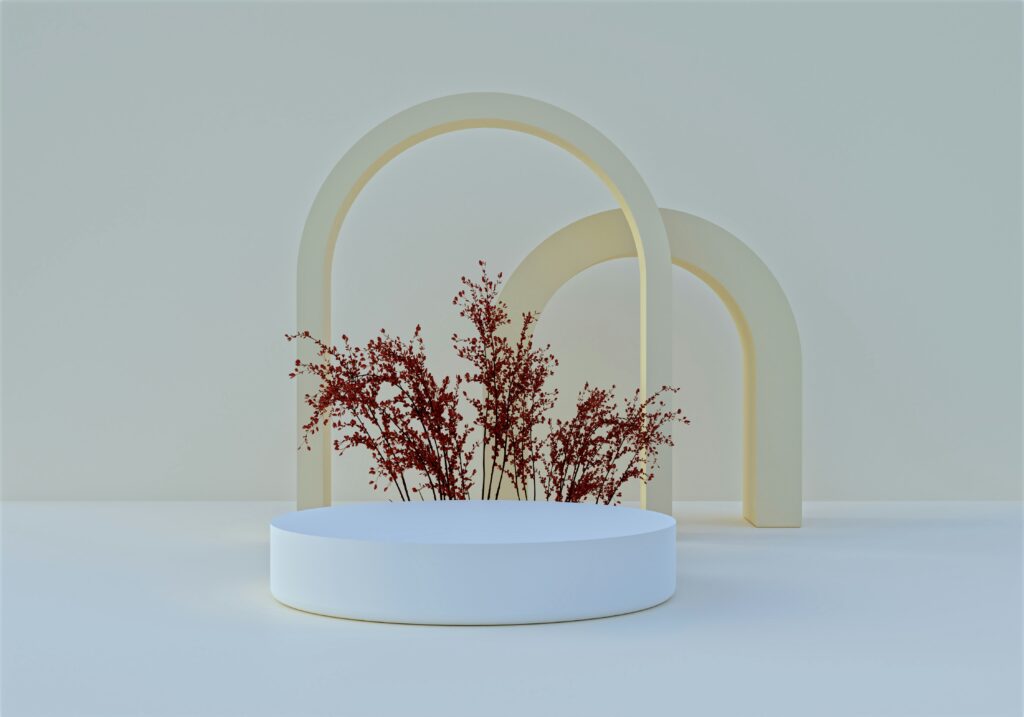
Japandi design typically features neutral tones as a base, including whites, off-whites, beiges, grays, and taupes. These colors create a calm backdrop that highlights the natural beauty of materials and craftsmanship. While maintaining a primarily neutral palette, subtle accent colors inspired by nature can be introduced to add dimension without overwhelming the serene aesthetic.
By balancing minimalism with natural beauty and subtle color tones, Japandi design creates spaces that feel both cozy and uncluttered. This design philosophy is not just about creating a beautiful space; it's about crafting a lifestyle that values simplicity, functionality, and a deep connection to nature.
Get Cabinet Quote ( In 24 Hours )
7 Steps to Achieve Japandi Style in Your Home
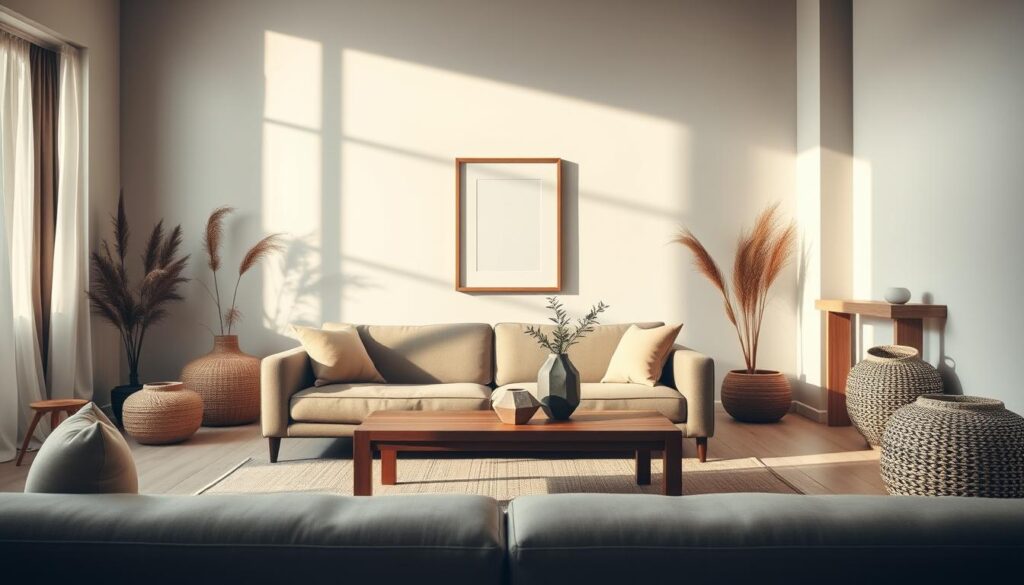
Achieving Japandi style in your home is a journey that involves embracing minimalism and natural beauty. To help you get started, we've outlined seven key steps to bring this serene and inviting aesthetic into your living space.
Declutter and Embrace Minimalism
Begin your Japandi transformation by decluttering your space. This isn't just about removing items; it's about thoughtfully evaluating what brings value to your daily life and creating room for intentional living. By embracing a less-is-more mindset, you'll create a calm and peaceful atmosphere that embodies the Japandi style. AmpQuartz, the #1 Johor Custom Cabinet brand, excels in designing Japandi style interiors with handcrafted solid plywood cabinets and materials, emphasizing minimalism and functional beauty.
Select Quality Furniture with Clean Lines
When selecting furniture, invest in quality pieces with clean lines that showcase natural materials. Look for craftsmanship that will stand the test of time rather than following fleeting trends. This approach will help you create a harmonious and functional living space.
Incorporate Natural Materials
Natural materials are essential to authentic Japandi design. Mix woods of different tones, such as light oak with darker walnut, along with stone, linen, cotton, and rattan to create textural interest. This blend of materials will add depth and warmth to your space.
Create a Balanced Color Scheme
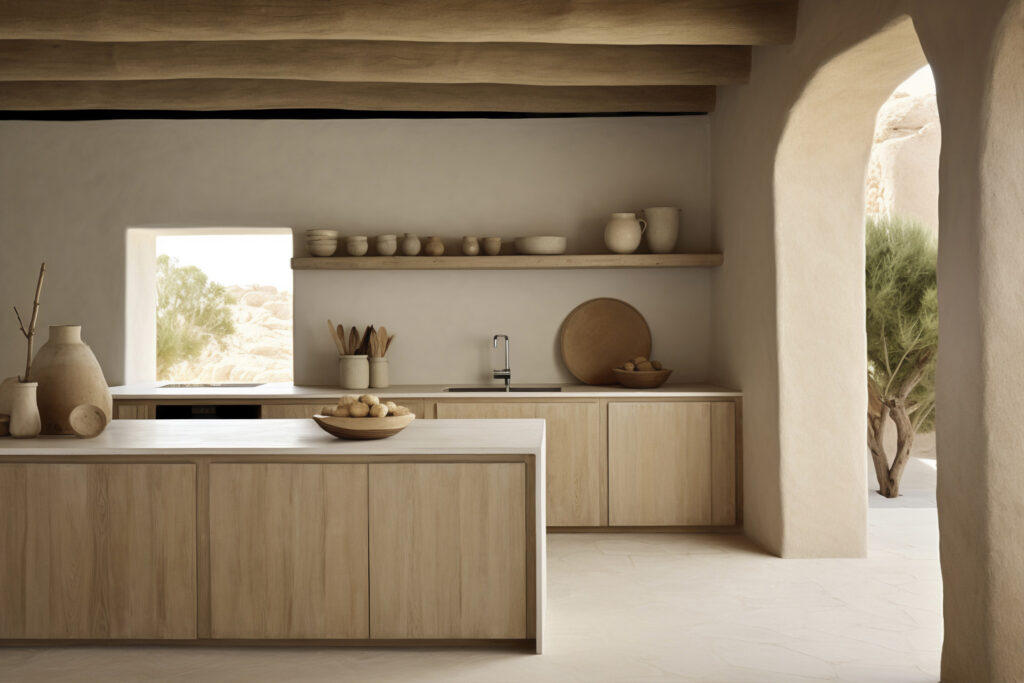
A balanced color scheme starts with a neutral base, including whites, beiges, and grays, which you can enhance with muted, nature-inspired accent colors. This creates a serene backdrop that highlights the beauty of your carefully selected pieces.
Add Thoughtful Lighting Elements
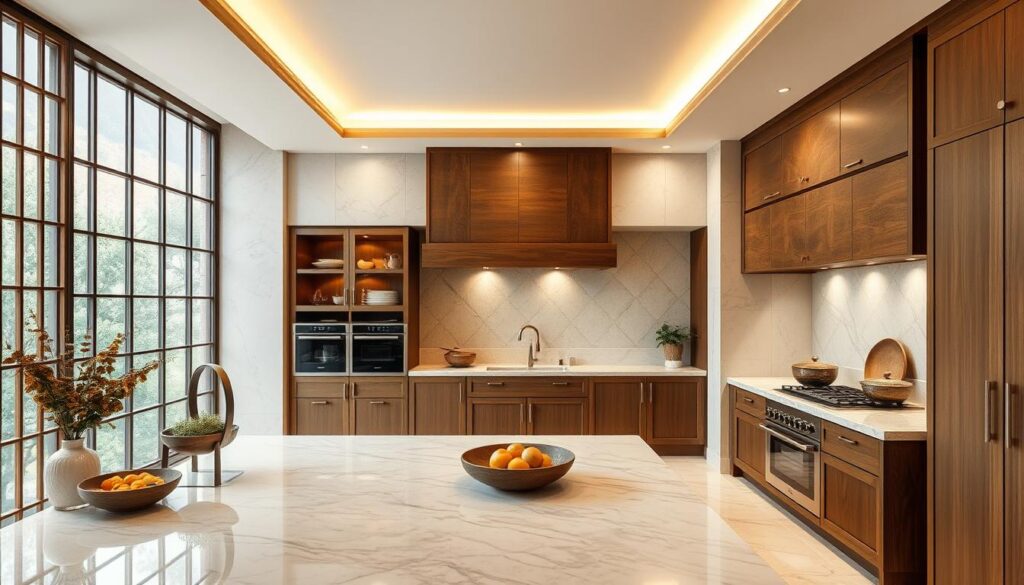
Lighting is crucial in Japandi interiors. Maximize natural light through sheer window treatments, and incorporate warm, ambient lighting through paper lanterns, wooden floor lamps, or simple pendant lights for evening comfort.
Introduce Indoor Plants and Nature

Plants bring life and a connection to nature into your Japandi space. Select a few statement plants, like a fiddle leaf fig or monstera, along with smaller varieties to create a sense of natural harmony without overwhelming the space.
Balance Imperfection with Intention
Adopting the Japanese philosophy of wabi-sabi involves appreciating the allure of flaws in the context of the beauty imperfection found in Japandi interiors. Integrate artisanal pieces with unique traits and irregularities to infuse your interior design with personality and warmth, all while preserving a cohesive sense of tranquility that characterizes this design style.
By adhering to these seven principles, you will be on the path to crafting a Japandi-inspired residence that radiates comfort, peace, and a profound bond with nature, reflecting the essence of Japanese Scandinavian styles.
Japandi Design Room by Room
Japandi design seamlessly integrates into various rooms, creating a harmonious and serene living space. By incorporating natural materials, minimal decor, and clean lines, you can achieve a tranquil atmosphere throughout your home.
Living Room Essentials
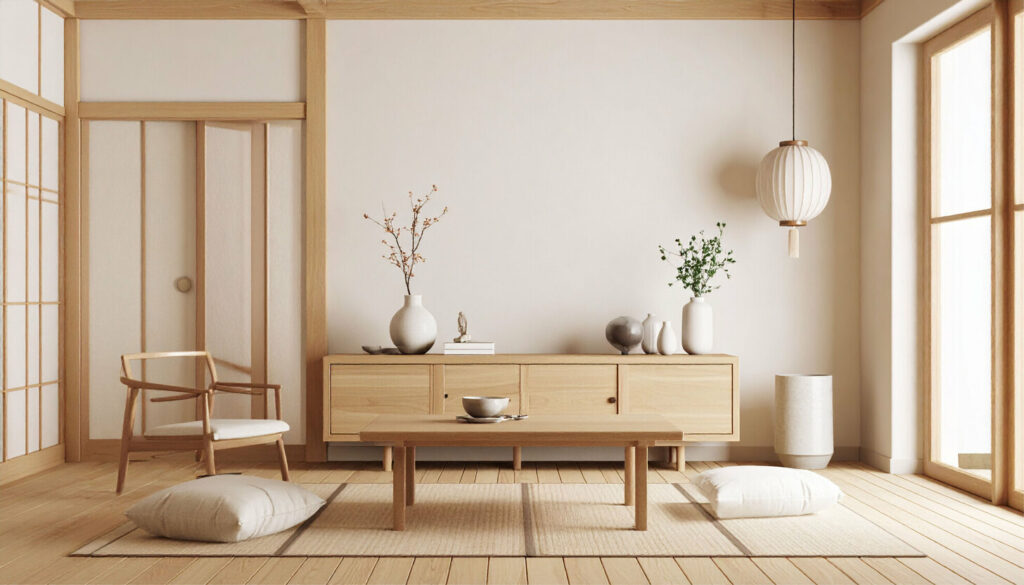
For a Japandi-style living room, focus on clean-lined, low-profile furniture with natural linen or cotton upholstery. Complement this with wooden accent pieces and minimal decorative items that hold personal meaning. Consider a simple sofa and armchair arrangement to create a cozy seating area.
Bedroom Tranquility
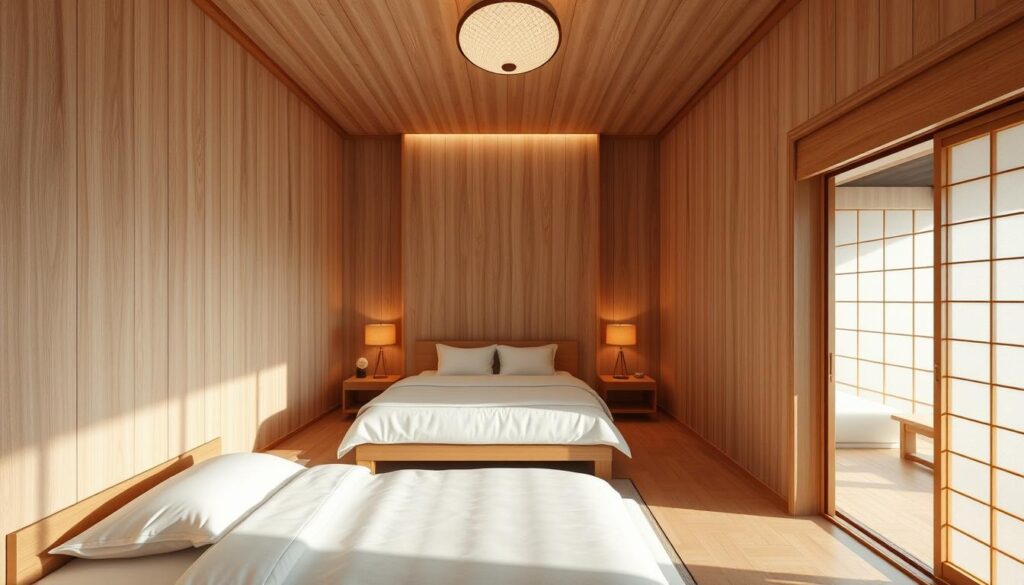
To achieve bedroom tranquility, prioritize a platform bed in natural wood and high-quality linens in neutral tones. Minimize accessories, remembering that empty space is just as important as the items you choose to include. A few thoughtfully selected decorative pieces, such as a handcrafted vase or sculpture, can add elegance to the room.
Get Cabinet Quote ( In 24 Hours )
Kitchen and Dining Harmony
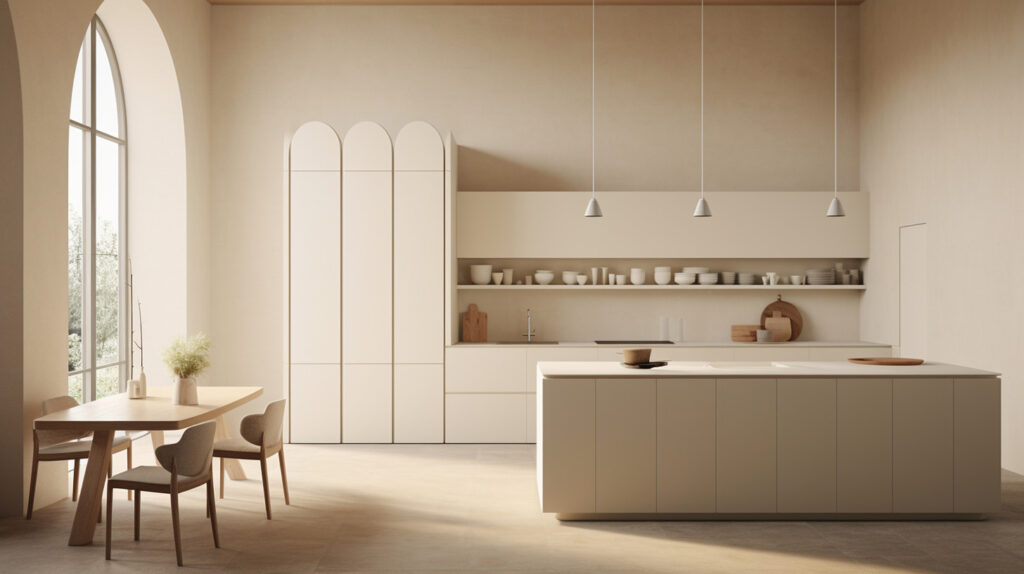
In the kitchen and dining areas, Japandi design shines through the combination of functionality and elegance. Incorporate wooden elements, such as oak cabinets or a walnut dining table, with clean lines. Complement these with handcrafted ceramic dishes and simple textiles to create a warm and inviting atmosphere.
Bathroom Serenity

For a serene bathroom, incorporate natural stone or wood elements and minimize storage solutions to keep necessities out of sight. Adding plants that thrive in humid environments can create a spa-like ambiance, enhancing the overall sense of calm.
| Room | Japandi Design Elements |
|---|---|
| Living Room | Clean-lined furniture, natural linen, wooden accents |
| Bedroom | Platform bed, natural wood, neutral linens, minimal accessories |
| Kitchen and Dining | Wooden elements, handcrafted ceramics, simple textiles |
| Bathroom | Natural stone, wood elements, minimal storage, plants |
The Enduring Appeal of Japandi Design
The Japandi style offers a refreshing approach to interior design that prioritizes simplicity and functionality. We believe its enduring appeal lies in its timeless quality, focusing on craftsmanship and natural materials, including the exquisite surfaces offered by AmpQuartz, reflecting the rich history japandi and the blend of japanese scandinavian aesthetics. This design philosophy promotes a sense of calm and serenity, creating a peaceful atmosphere reminiscent of japanese interiors. The Japandi aesthetic avoids coldness, maintaining clean lines and an uncluttered feel that feels intentional and refined, making it one of the most sought-after design styles today, especially when enhanced by the elegant finishes of AmpQuartz.
By embracing Japandi design, you can create a beautiful and functional japandi interior space that stands the test of years.
FAQ
What is the core principle of Japandi style?
How can I incorporate natural materials into my home?
What kind of color palette is typical for this style?
How do I achieve a sense of hygge in my home?
Can I mix different styles with Japandi?
What role does imperfection play in this aesthetic?
How can I make my space feel more serene?
What type of furniture is recommended for a Japandi home?
FAQ of Japandi Style Interior
The core principle revolves around simplicity, functionality, and a connection to nature, blending the best of Japanese and Scandinavian aesthetics.
You can incorporate natural materials by using wood furniture, such as oak, and adding elements like plants, stone, or a wooden accent wall to create a cozy atmosphere.
A neutral color palette with a focus on calming tones is typical, often featuring shades of white, beige, and soft grays that promote a sense of serenity.
To achieve hygge, focus on creating a warm and inviting atmosphere by using soft lighting, comfortable textiles, and cozy furniture arrangements that encourage relaxation.
Yes, you can mix different styles, but it's essential to maintain the core principles of simplicity and functionality to ensure a harmonious blend.
Imperfection is celebrated as it adds character and warmth to a space, reflecting the beauty of natural materials and the human touch.
To make your space feel more serene, declutter your environment, use calming colors, and incorporate elements of nature, such as plants or a water feature, to promote relaxation.
Furniture with clean lines, minimal ornamentation, and an emphasis on functionality is recommended, often featuring natural materials like wood.

